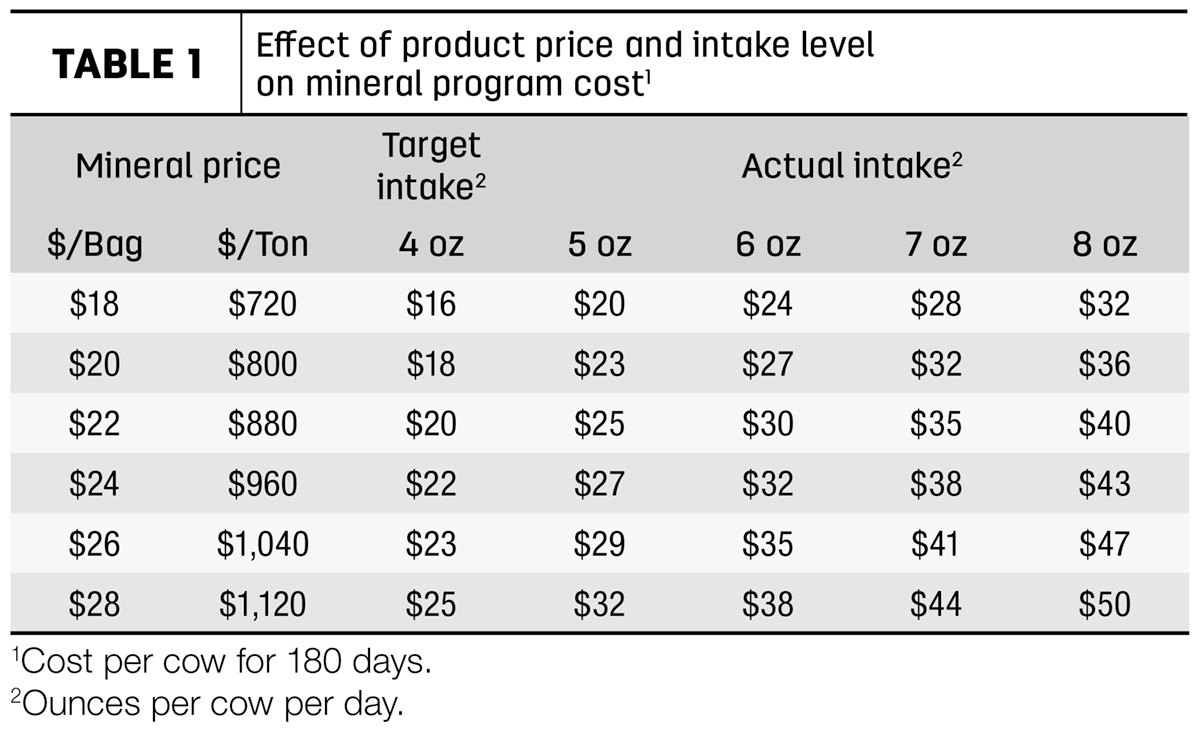Understanding the impact of mineral and vitamin intake in relation to requirements and associated responses in health and performance is a very challenging aspect of beef cattle nutrition. Plant mineral content is influenced by soil and water, and both forage and water contribute to the total amount consumed by cattle aside from supplementation. Due to this interaction, both mineral levels found in forages and cow herd status can be highly variable both locally and regionally throughout the U.S. While other methods of providing minerals and vitamins to cattle exist, supplementing with dry granular products in a free-choice manner would be common for many producers year-round. It is always good practice to review the fundamentals of a mineral program, and the following are 10 important factors to keep in mind.
- Remember the priority of nutrients. While minerals and vitamins are important for a myriad of biological processes that ultimately impact measurable production outcomes such as calving intervals and weaning weights, it is essential we keep the hierarchy of nutrients in mind. Energy and protein are of higher priority than minerals and vitamins. In situations when protein or energy are deficient, supplementing greater levels or different sources of minerals and vitamins will have limited impact and will not offset a deficiency of either of the two more important nutrients. When concerns regarding reproduction or calf performance arise, mineral or vitamin status of a cow herd is often questioned. Only after important production calculations (i.e., calf crop weaned per cow exposed) are made and the adequacy of the key components (energy, protein) of the cow herd nutrition program are assessed should minerals and vitamins be further evaluated.
- Take time to plan what your needs will be. While estimating product usage can be challenging, accurately budgeting how much mineral you will use for the next several months or even the entire year can help avoid under- and over-purchasing. This is important because either can impact cash flow needs for an operation. Your feed service provider can help estimate mineral usage based on how products are designed. Perhaps more importantly, regular conversations with your supplier also help them better understand you and your operation so they can be of greater service by providing you what you really need.
- Measure intake to help plan your needs. Record when and how much mineral is being put out for a group of cows and track consumption on a pasture or group basis. Doing so regularly over the course of a season will help determine average consumption and identify intake patterns, which can aid in making informed management decisions. Remember, while we may observe a wide range in actual consumption, we are targeting an average per label directions.
- Both management and ingredients used impact consumption. How we manage free-choice supplements can certainly influence animal consumption. Proximity to water and resting areas, water source, supplementation of other feedstuffs, precipitation, feeder design and number of animals per feeder all drive consumption, either positively or negatively. While greater levels of magnesium are typically associated with decreased voluntary intake, salt may either stimulate or inhibit consumption. Inclusions of other products such as flavoring and anti-caking agents typically improve consumption. Dried distillers grains, soybean meal and wheat midds are commonly used as “carriers” to which other mineral sources and ingredients are added in a mineral formula, and the amount that such products are used greatly influences consumption.
- Read, understand and follow label directions. All commercially manufactured mineral supplements must have the following information listed in the proper place on the affixed label: product name and purpose statement, medication claim and dosage level if applicable, guaranteed analysis of nutrient fortification, included ingredients, clearly stated feeding directions, precautionary statements if applicable, manufacturer’s name and address, and a statement guaranteeing the net quantity in the package sold. It is particularly important with medicated minerals that one clearly understands what the product is medicated with, what the dosage and units used are, and the intended use of the product. Medications added to products are often labeled in grams per ton, while the feeding directions may be listed in terms of pounds of product necessary to supply a certain level of milligrams per head per day of the medication. Grams per ton divided by 2 equates to milligrams per pound. Likewise, milligrams per pound multiplied by 2 equals grams per ton.
- There can be value in custom products. Accurate forage and water analyses can aid in the formulation of custom products, which may be appropriate and economical for some operations. It is common for manufacturers to require volume minimums on custom products, often due to mixing and facility logistics. Product quality and consistency is an important consideration with custom blends.
- Focus on C and P. Calcium (C) and phosphorus (P) are two of the most important macrominerals, and requirements for the beef cow change throughout the year, similar to energy and protein. Calcium and phosphorus needs increase as pregnancy advances toward parturition due to the demands for fetal growth, and reach their peak approximately two months later due to lactation. The phosphorus requirement for a 1,200-pound lactating cow grazing a forage containing on average 0.2% phosphorus (dry matter basis) would be exceeded by 4 ounces per head per day of a mineral containing 6% phosphorus, thus providing some margin if forage is of lower phosphorus content than assumed.
- Keep salt in mind. Salt is often added to free-choice mineral supplements to regulate intake and is a relatively low-cost ingredient. If a free-choice mineral supplement contains 25% salt, 4 ounces per head per day of consumption would provide 28 grams per head per day of salt or 11 grams per head per day of sodium, which would meet the sodium requirements of a typical beef cow. Therefore, feeding a product containing at least 25% salt would not require additional free-choice salt to be fed based on meeting the sodium needs of a beef cow.
- Micros come in varying packages. Many different sources of trace minerals exist in the feed ingredient market, from oxide and sulfate sources to chlorides to hydroxychlorides to amino acid complexes, chelates and proteinates. They all have a proper place in which they can be effectively used for the benefit of the animal. In general, as we advance from oxides and sulfate sources to more complexed sources, both absorption and cost increase. Again, a conversation with your feed service provider can help you navigate the intended use of products based on their trace mineral source, as well as ensure the cost difference is within your budget.
- Avoid overconsumption. With current prices, a sound and well-managed mineral program can be implemented for $40 to $50 per cow per year (see Table 1). These costs must be weighed relative to other feed costs and the value of cows and calves. While underconsumption can certainly be costly if deficiencies arise, overconsumption of a mineral product is likely to occur more frequently and represents additional costs that should be retained to improve profit margin per cow.










